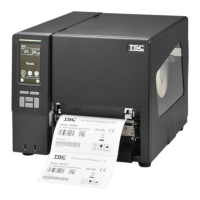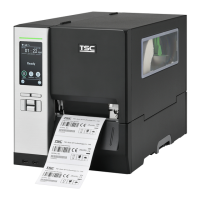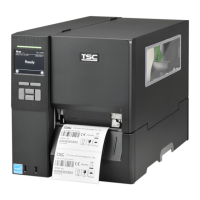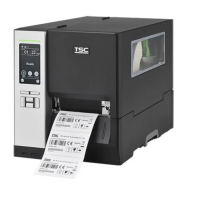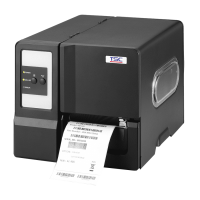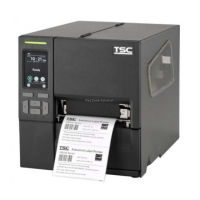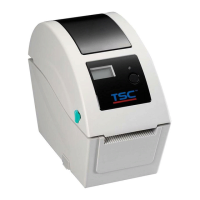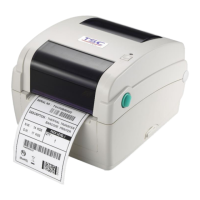Why does my TSC MH261T say 'Carriage Open'?
- NNoah ClarkSep 9, 2025
The 'Carriage Open' message on your TSC Barcode Reader indicates that the printer carriages are open. Please close the print carriages.
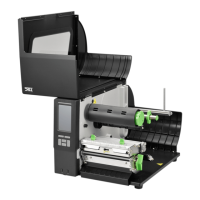
Why does my TSC MH261T say 'Carriage Open'?
The 'Carriage Open' message on your TSC Barcode Reader indicates that the printer carriages are open. Please close the print carriages.
Why is my TSC MH261T label feeding not stable?
If the label feeding on your TSC Barcode Reader is not stable (skewed) during printing, the media guide might not be touching the edge of the media. If the label is moving to the right, move the label guide to the left. If the label is moving to the left, move the label guide to the right.
Why is my TSC Barcode Reader printing a gray line on the blank label?
If your TSC Barcode Reader is printing a gray line on the blank label, the print head or platen roller might be dirty. Clean the print head and platen roller.
Why is my TSC MH261T Barcode Reader not printing?
Your TSC Barcode Reader might not be printing because the interface cable isn't properly connected, or the wireless or Bluetooth device isn't well connected. Also, the port specified in the Windows driver might be incorrect. Re-connect the cable or try a new one. Reset the wireless device setting. Select the correct printer port in the driver. Ensure the printhead’s harness connector is well connected with the printhead by turning off the printer and plugging the connector again. Check your program for a PRINT command at the end of the file and ensure each command line ends with CRLF.
What to do if my TSC Barcode Reader is missing printing on the left or right side of label?
If your TSC Barcode Reader is missing printing on the left or right side of the label, the label size setup might be wrong. Set the correct label size.
What to do if my TSC MH261T LCD panel is dark but the LEDs are light?
If the LCD panel on your TSC Barcode Reader is dark but the LEDs are lit, the printer initialization may have been unsuccessful. Turn OFF and ON the printer again and initialize the printer.
Why is my TSC MH261T Barcode Reader LCD panel dark and keys not working?
If the LCD panel on your TSC Barcode Reader is dark and the keys are not working, the cable between the main PCB and LCD panel might be loose. Check if the cable between the main PCB and LCD is secured.
How to fix irregular printing on TSC MH261T?
Irregular printing on your TSC Barcode Reader can occur if the printer is in Hex Dump mode or if the RS-232 setting is incorrect. Turn the printer off and on to skip the dump mode. Re-set the Rs-232 setting.
What causes wrinkle problem with TSC MH261T Barcode Reader?
Wrinkling during printing with your TSC Barcode Reader can be caused by incorrect printhead pressure, improper ribbon or media installation, incorrect print density, or incorrect media feeding. Please refer to section 4.2. Set the suitable density for good print quality. Make sure the label guide touches the edge of the media guide.
Why does my TSC MH261T say 'No Ribbon'?
The TSC Barcode Reader might display 'No Ribbon' because the ribbon roll has run out or the ribbon is installed incorrectly. Supply a new ribbon roll and refer to the user’s manual for instructions on reinstalling the ribbon.
| Brand | TSC |
|---|---|
| Model | MH261T Series |
| Category | Barcode Reader |
| Language | English |
An overview of the MH261T/MH361T Series thermal transfer bar code printers.
Detailed technical specifications and features for the MH261T and MH361T models.
Guide to unpacking and inspecting the printer and its included accessories upon receipt.
Identification of external components and controls visible on the printer's front panel.
Diagram and labeling of the printer's front components and controls.
A detailed diagram illustrating and labeling the printer's internal mechanisms and parts.
Diagram showing rear panel connections and ports of the printer.
Explanation of LED status indicators and the functions of the printer's physical control keys.
Explanation of LED status indicators and the functions of the printer's physical control keys.
Interpretation of icons displayed on the LCD control panel and their meanings.
Instructions for navigating and interacting with the printer's touch-sensitive LCD interface.
Procedures for the initial physical setup and connection of the printer to a power source and host.
A step-by-step guide on how to correctly install a ribbon into the printer.
Instructions for safely removing a spent ribbon from the printer.
Detailed guide for loading various types of media rolls and labels into the printer.
Specific instructions for loading fan-fold media into the printer.
Guide for loading media when using the optional peel-off feature for label dispensing.
How to adjust the print head pressure for optimal print quality on different media.
Techniques for adjusting internal mechanisms to prevent ribbon wrinkling during printing.
Procedures for accessing the printer's main menu via touch panel or physical keys.
A summary of the six main functional categories available within the printer's menu system.
Configuration options for printer settings when using the TSPL command set.
Configuration options for printer settings when using the TSPL command set.
Configuration options for printer settings when using the ZPL2 command set.
Process for automatically calibrating the printer's media gap and black mark sensors.
Process for automatically calibrating the printer's media gap and black mark sensors.
Manual setup, threshold detection, max length, and advanced sensor configurations.
Configuration settings for the RS-232 serial communication interface.
Configuration settings for the RS-232 serial communication interface.
Settings and status check for the printer's Ethernet network connection.
Management of Bluetooth status, local name, and PIN code settings.
Configuration and status management for the Wi-Fi wireless network interface.
Settings for the General Purpose Input/Output (GPIO) interface for external device control.
Configuration of language, display brightness, date, and time.
Configuration of language, display brightness, date, and time.
Accessing printer information, performing initialization, and touchscreen calibration.
Calibrating the touchscreen for accurate input response.
Setting passwords, managing ribbon warnings, and print head care procedures.
Configuring key sound and accessing technical support contact information.
Managing files stored in the printer's DRAM memory.
Managing files stored in the printer's DRAM memory.
Managing files stored in the printer's Flash memory.
Managing files stored on the SD card installed in the printer.
Printing printer configuration details and a print head test pattern for diagnostics.
Printing printer configuration details and a print head test pattern for diagnostics.
Capturing and printing communication port data for debugging purposes.
Checking print head temperature, resistance, and bad dots for performance.
Checking the status of the printer's display and sensor readings.
Guide to customizing the printer's menu by adding frequently used settings to Favorites.
Methods and tools for cleaning printer components to ensure optimal performance.
Procedures and recommendations for safely disinfecting the printer.
